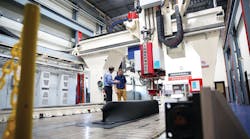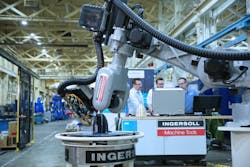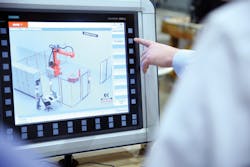Siemens and Ingersoll Machine Tools Expanding Digital Enterprise Partnership
Siemens and Ingersoll Machine Tools have expanded their decade-long partnership to support the Rockford, IL-based machine tool company of Camozzi Group on its digital journey of creating digital twins of its products and expanding into new markets. Based upon extensive experience in heavy machine tool building, Siemens' cutting-edge technologies in hardware complement Ingersoll Machine Tools’ successful journey into the new market of additive manufacturing and have pushed the boundaries for industrial robots for the aerospace market with its entry-level robotic platforms MasterPrint Robotic and MasterPrint Continuous Filament.
For example, Ingersoll developed the mammoth 3D printer MasterPrint, the world’s largest device that prints with thermoplastics. The MasterPrint at the University of Maine—included in the Guinness Book of World Records—is able to 3D-print objects up to 100-ft long, 20-ft wide, and 10-ft tall. It is designed mainly to make tools for the aerospace, space, and marine industry. MasterPrint cuts cost and streamlines the manufacturing process. Large parts are printed and then machined to final their shape with the same machine. Manufacturing costs can be reduced by 75% and lead times shortened from months to days.
“As a key supplier of high-tech manufacturing equipment to all the major players of the aerospace industry, Ingersoll has strategic technology goals that push CNC product capabilities and performance beyond their OEMs’ intentions, conception, and scope in term of accuracy, reliability, ease of integration and seamless programming experience. Ingersoll has found a CNC and software partner in Siemens who is willing to develop and encompass these advanced capabilities into their products and to enable Ingersoll to achieve its strategic goals and service the needs of our customers by shortening their time-to-market and increasing their profitability," said Piergiorgio Assandri, Business Director, Ingersoll Machine Tools.
“Ingersoll Machine Tools’ ambitious plans for becoming a leading digital enterprise in the machine tool market are impressive. Their successful additive manufacturing and industrial robot products are a proof point for this. Ingersoll Machine Tools’ entrepreneurial spirit and innovative approach has pushed us to the limits, what our technology is capable of, and inspired us to go even further," said Rajas Sukthankar, Vice-President of Siemens Digital Industries Motion Control Business (US).
Ingersoll Machine Tools is using cutting-edge CNC automation hardware and software from Siemens to transform their business for the digital age. With the Siemens Virtual NC Kernel (VNCK), the company was able to embed the real CNC kernel into a virtual machine, allowing Ingersoll Machine Tools to completely emulate real machine tool control and directly import the commissioning archive of the actual machine. That helped Ingersoll Machine Tools to save time with faster commissioning and to get the machine to their customers faster. From an end-customer perspective, users will be able to simulate the manufacturing of their product and shorten their time-to-market while increasing their production quality.
“Composite production processes such as the increasingly popular robotic applications can have quite complex machine motions and tight manufacturing tolerances, as well as the ever-present need to reduce production times. Having a virtual version of the CNC kernel directly integrated within the programming and simulation software environment allows a customer to more reliably validate their production processes and timing before physically running anything on the machine,” said John Dreher, Software Engineering Manager, Ingersoll Machine Tools.
To handle the complex machining applications, Ingersoll Machine Tools chose the modular, scalable, and open Sinumerik 840D sl CNC system from Siemens, which is considered to be the control of choice in high-end machining segments like aerospace. High CNC machining performance, along with flexibility and openness, represents the basis for almost every machine tool concept.












